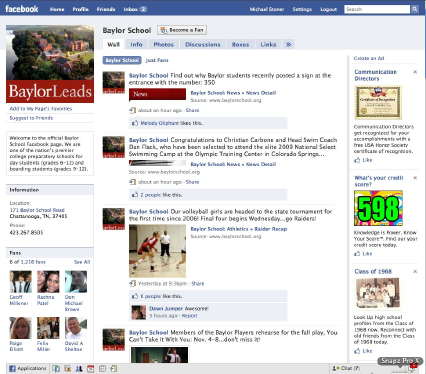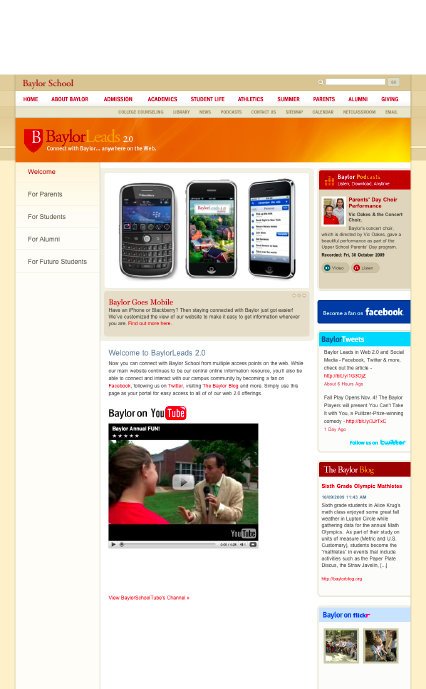Small Staff, Smart Choices Yield Social Media Success So Far for Baylor School
Oct 29, 2009

Immersing yourself in social media isn’t easy when you manage communications and marketing for an education institution, even a small one. There’s already a lot on your plate: events to produce and publicize, magazines to put out, a website to update. That’s certainly true at the Baylor School, a boarding and day school in Chattanooga, TN, where Barbara Kennedy, associate vice president for external affairs, manages communications.
Kennedy’s team is responsible for marketing, media relations, publicity, PR, publications, a magazine, BaylorSchool.org, and programming and promoting the school’s summer programs. It’s a small staff: just Kennedy with a director for summer programs, a webmaster, a designer, and a freelance editor who helps with the school’s magazine.
Despite the existing workload, Kennedy knew that it was important to learn about social media and to incorporate these tools into her work. “I knew that I had to be responsive. I’m a 25-year PR veteran and I knew I had to adjust to these changes myself. And I know our audiences expect us to communicate in this way.”
So in spring, 2009, she and Bernard Fertal, Baylor’s webmaster, began exploring social media. “We wanted to be in the lead, but we didn’t want to proceed without really thinking through the advantages and disadvantages,” Kennedy said. “I think some people thought social media was just a fad that would soon fade away—and still others chose to ignore it. But we looked at it as a revolution in how we do our jobs.”
After some experience, she added, “Bottom line: we look at social media as a powerful way to leverage traditional marketing and communication tools that we already have in place.”
Pilot project focused on a class trip
After doing some exploration and research, Kennedy developed a pilot project to launch over the summer, when she had time to focus on it: a travel blog about a student trip to Washington D.C. with photos posted on Flickr. “This was only read by the students who were on the trip and their parents and there wasn’t much interaction, but it gave me a reality check on the time commitment. Then we started tweeting. And I had already been immersed personally with Facebook, so the Baylor School fan page was the next logical step once classes began in August.”
These continue to be her focus. “I’m amazed at how quickly the Facebook page took off: it has grown virally, as has @BaylorSchool [1216 fans and 103 followers as of 28 October 2009]. We plan to do a radio promotion directing people to follow us on Facebook and Twitter, so we’ll see how those numbers grow.”
Kennedy’s main focus is The Baylor Blog, which feeds the fan page. She said, “Since I am generating all of the news items on our website and much of the information that we share with parents and students on a regular basis, I do the updates on Facebook and the blog.”
Tweets are drawn from the school’s daily announcements and other web content and lead back to news stories on BaylorSchool.org. Fertal manages @baylorschool and handles most of the tweets.
As a communicator, Kennedy appreciates the flexibility social media gives her in telling a story—and allows her to watch how her stories spread. “As someone in communications, the feedback and data I get on posts is invaluable.” As an example, she talked about some photos she posted of Korean students celebrating a Korean holiday. “I’m interested to see how many of those kids will interact, showing me if it’s viable to reach students in Asia this way. I may not get much interaction, but I’m watching what happens.”
Kennedy also appreciates how much she can learn about her audience. “Our total fan base is predominantly ages 13–24, almost evenly split male/female. As a boarding school, it is also of great value to see that 1,002 of our Facebook fans are from outside of the state, and 39 of those fans represent 19 different countries. Having the data also informs my choices on what to post, and will no doubt shape our communication strategies in the coming months. For example, 100% of the interaction has been from females (ages 35–44, 40 percent), (ages 45–54, 40 percent), (ages 13–17, 13 percent), and (ages 55+, 7 percent).”
She continued, “This week, we have pulled in 17 percent participation from males and our younger fans are becoming more active. So I’m thinking harder about posts that I feel will keep connecting with them. Our next step is to leverage this information with admission and fund-raising.”
And this data helps her to gain support from Baylor’s board. “I felt that some of my colleagues were just being polite when I talked about social media, but when I shared some of this data with the board, they really responded. They got that it was a whole new way of communicating.”
Challenges? What challenges?
When asked about challenges in putting social networking into practice, Kennedy said, “It has been ridiculously easy, but it was personally scary for me to let go of some of the control. I was blocked for awhile on creating the fan page because I wasn’t sure anyone would respond to it. Silly, huh?”
Kennedy and Baylor have not encountered any discipline problems or issues with their own ventures in social networking, but that doesn’t mean that Kennedy hasn’t had “an aha moment” around potential abuses of social networking. “A couple of years ago, a reporter ‘friended’ some students on Facebook to get a quote regarding a controversial issue on campus. He ran the story with a student’s quote and I was just blown away. Because I also handle media relations, it was a teachable moment for me, the student, and others in our school community. That was my first experience with Facebook—and, when you think about it, it’s a miracle that I grew to love it!”
Although being an active blogger and Facebooker take more time in her day, it hasn’t been a big burden for Kennedy. “Honestly, it takes me just a few more minutes a day. I would be developing news content for the website anyway, so copying and pasting into the fan page and tweeting about it—is really just a few extra minutes.”
Even the interaction is manageable, Kennedy has found. “I don’t follow up much, though I do spend time reading comments and think about how they might inform what I post. For Twitter, I’m looking at what people are reading, RTing, and I’m thinking about they say. This takes 10–20 minutes a day. I could spend more time on it, but I don’t. I have to set some boundaries.”
The effort she’s put into social media-and its payback-have resulted in some plans for the near future:
-
- Silverpoint, Baylor School’s web partner, is designing a mashup page that pulls together the school’s various feeds; it should go live this fall.
-
- Kennedy is also exploring how she can incorporate a Flip video camera and iMovie into her communications retinue, and her immersion in social media is causing her to rethink how she will present Baylor’s magazine when it moves online. The current print magazine is mailed twice a year to 10,000 people. Kennedy isn’t sure what an online version of the magazine will look like, but she is sure that her effort won’t involve slapping a PDF on BaylorSchool.org. “I’m thinking about how we can tell stories through video and audio,” she said.
-
- Finally, there’s a need for other voices to join the conversation online. She’d like to include more student voices, but that hasn’t happened much yet. One of her concerns is the amount of time they could spend: “I don’t have a lot of confidence in their level of commitment to it—they have a whole lot of things going on,” she said. And she’d like to see other departments involved in contributing to and sustaining Baylor’s social media activities. “We need other voices to join the conversation and in doing so contribute to the effort,” she said.
Note: This post is the result of research and interviews for an article on innovations in social media by independent schools. It will appear in the January 2010 issue of CASE Currents. There are four related posts:
-
- An interview with Chuck Will, from Proctor Academy, Innovator: Chuck Will, The Longest-Running Blogger in Education?;
- A case study on how Northfield Mount Hermon School’s new website will incorporate social media;
- A post about online life at Worcester Academy.
- A case study of social media in action at Beaver Country Day School
- .
Update: The mashup page went live the week of 2 December:

-
Michael Stoner Co-Founder and Co-Owner Was I born a skeptic or did I become one as I watched the hypestorm gather during the dotcom years, recede, and congeal once more as we come to terms with our online, social, mobile world? Whatever. I'm not much interested in cutting edge but what actually works for real people in the real world. Does that make me a bad person?